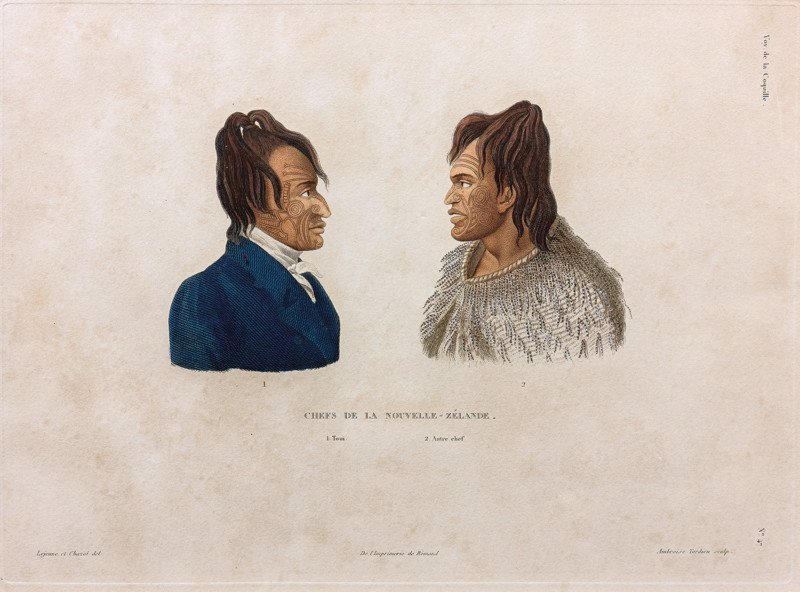LEJEUNE, Jules Louis; CHAZAL, Antoine;
Chiefs of New Zealand: Tuai and Another Chief
1826
Hand-coloured engraving on paper
340 x 555mm

Original title: ‘Chefs de la Nouvelle-Zélande: 1. Touï, 2. Autre chef’. Engraved by Ambroise Tardieu. Plate No. 47 from Louis Isidore Duperrey, Voyage autour du monde, exécuté par ordre du roi, sur la corvette de Sa Majesté, la Coquille, pendant les années 1822, 1823, 1824, et 1825 (Paris: Arthus Bertrand, 1826). Other lithographs from the series can be viewed here.
The following text comes from the catalogue for the exhibition Tirohanga Whānui.
Chazal has combined two distinct images chosen from Lejeune’s original drawings. The subjects are Tuai, chief of Kahuwera, and another unnamed chief. Lesson’s account described Tuai in detail:
‘Before long a native in European dress came on board. He spoke English having spent some time in England where he and the chief Terri [Tītere] had been taken by the brig Kangaroo, and he introduced himself to us. Toui, brother of the famous Korokoro, whom he had succeeded as chief of Kaouera i-pah [Kahouwera] was the bearer of numerous English and American certificates which testified to the service he had rendered to various navigators, and from that moment on he was everybody’s pet … He persuaded us to shift anchorage and to go closer to his fortified village or i-pah. He was a man of medium build, about thirty years old, with an elegantly tattooed face; his manners were common and very stiff in the European dress he wore when with us.’
In 1818 and 1819, through the auspices of the missionary Thomas Kendall, the young chiefs Tuai and Tītere, preceding Hongi and Waikato by two years, had travelled to visit the linguist Professor Samuel Lee at Cambridge University, where they assisted him in the preparation of his work on Māori vocabulary and grammar.
D’Urville, writing his own account published in 1831 of the 1826–29 voyage of the Astrolabe, had this to say of Tuai:
‘Although Touai had taken much greater pains than Shongui [Hongi] to imitate the manners and the general appearance of Europeans, at bottom he had not benefited any more from his trip to England, so far as principles are concerned. He was just as addicted as any of his compatriots to the tastes, customs and superstitions of his land. Only being more skilful, more ingratiating and more determined to pay court to Europeans, Touai took the greatest care to disguise his conduct and feelings under the outward signs of civilisation, and this savage had all the sagacity characteristic of a professional courtier. Thus, throughout our stay in Paroa Bay, we had nothing but praise for his behaviour and even for his acts of kindness. Always guided by his one motive, he hoped to obtain from us a lot of powder and muskets.’
Exhibition History
Tirohanga Whānui: Views from the Past, Te Kōngahu Museum of Waitangi, 15 April to 15 September 2017

